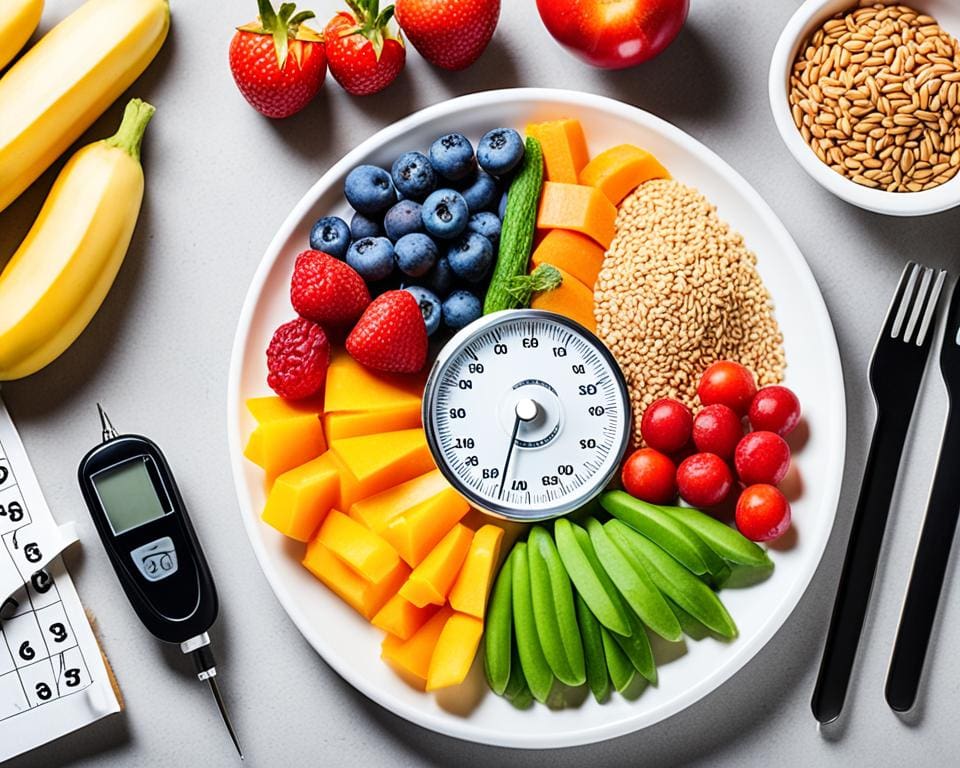In recent years, science has shown that type 2 diabetes can be reversed with lifestyle changes and weight loss. By understanding how insulin resistance and glucose control work, you can lower your blood sugar levels. This might even help you remit type 2 diabetes1.
The American Diabetes Association (ADA) and the European Association for the Study of Diabetes (EASD) published a report in 2018. They talked about managing high blood sugar in Type 2 diabetes. They stressed the need to fight insulin resistance1. Carrying extra weight, especially around the stomach, can make insulin resistance worse. Losing about 15kg is key for many with type 2 diabetes to stop the condition2.
There’s a theory called the Personal Fat Threshold. It says everyone has a limit for how much fat they can store in their liver and pancreas. Going over this limit can lead to type 2 diabetes. Even if you’re not overweight, hidden fat can still be a problem. Losing about 10% of your body weight is a good goal2.
The Counterpoint study from 2011 shed light on the Twin Cycle Hypothesis. This theory explains why type 2 diabetes happens2. This research has led to new ways to reverse the condition. These methods focus on reducing fat in the liver and pancreas.
Key Takeaways
- Type 2 diabetes is caused by insulin resistance, often driven by excess weight and visceral fat.
- Weight loss of around 15kg is necessary for most people to reverse type 2 diabetes.
- The Personal Fat Threshold concept suggests that individuals have different levels of tolerance for fat accumulation in the liver and pancreas.
- The Twin Cycle Hypothesis, proven by the Counterpoint study, explains the underlying cause of type 2 diabetes.
- Targeted lifestyle changes and weight loss can help lower blood sugar levels and potentially achieve remission of type 2 diabetes.
Understanding Type 2 Diabetes
Type 2 diabetes is a chronic condition that affects how your body uses glucose for energy. In the U.S., type 2 diabetes makes up about 95% of diabetes cases3. Over 34 million Americans have this type of diabetes, with most having type 24. Also, around 88 million people in the U.S. have prediabetes, which can lead to type 2 diabetes4.
Insulin Resistance and Blood Sugar Levels
Insulin resistance is a big part of type 2 diabetes. When your cells don’t respond well to insulin, you need more insulin to get glucose in. Over time, people with type 2 diabetes might need more than just diet and exercise to manage it5. High blood sugar levels can cause serious health problems if not controlled.
Risk Factors for Type 2 Diabetes
Many things can make you more likely to get type 2 diabetes, such as:
- Being overweight, especially around the stomach, can make insulin resistance worse3.
- Bad diets, not exercising, and your genes are big reasons for type 2 diabetes3.
- Your genes can affect your risk of getting type 2 diabetes3. Studies show over 70 genes are linked to it5.
- If your mom had gestational diabetes, you’re more likely to get diabetes later3.
- Some foods are cheaper and easier to find in some areas, making diabetes more likely. The way people view food can also affect diabetes rates in certain groups3.
| Foods that Increase Diabetes Risk | Foods that Do Not Increase Diabetes Risk |
|---|---|
| Sugar | Vegetables |
| Fried foods | Fruits |
| Fatty foods | Lean meats |
| Simple carbohydrates | Fiber-rich foods |
| Processed foods |
To prevent diabetes, eat well and stay active3. Changing your diet and moving more can help manage or even reverse type 2 diabetes4.
The Role of Lifestyle in Type 2 Diabetes
Lifestyle choices are key to fighting and managing Type 2 diabetes. By focusing on diet, exercise, stress, and sleep, you can lower your diabetes risk or better manage it if you have it6.
Diet and Nutrition
What you eat is crucial for managing Type 2 diabetes. Eating too much processed food, sugar, and unhealthy fats can raise your diabetes risk. But, eating more veggies, fruits, lean proteins, and fiber can help prevent and control diabetes7.
Fiber slows down sugar absorption, lowers blood sugar, and helps with weight loss7. Choosing unsaturated fats over saturated fats in dairy and meats can keep your blood cholesterol healthy7.
Physical Activity and Exercise
Being active is vital for better insulin use and metabolic health. The American Diabetes Association suggests at least 30 minutes of exercise daily to manage blood sugar8. Adults should aim for 150 minutes of moderate to vigorous activity weekly7.
Include resistance exercises like weightlifting, yoga, and calisthenics for strength and balance7. Even short breaks from sitting can help control blood sugar7.
| Lifestyle Factor | Recommendations |
|---|---|
| Diet | Focus on vegetables, fruits, lean proteins, and dietary fiber; limit processed foods, added sugars, and unhealthy fats |
| Physical Activity | Aim for at least 30 minutes of physical activity most days of the week; include both aerobic and resistance exercises |
| Stress Management | Practice stress-reducing techniques like meditation, deep breathing, or engaging in hobbies |
| Sleep | Prioritize getting 7-9 hours of quality sleep each night; address any sleep disorders like sleep apnea |
Stress Management and Sleep
Stress and lack of sleep can hurt your blood sugar control. Using stress-reducing methods like meditation or hobbies can help. Getting 7-9 hours of sleep a night is key for healthy blood sugar levels. Treating sleep disorders like sleep apnea can also help manage diabetes6.
Changing your lifestyle can greatly lower your risk of getting Type 2 diabetes or improve it if you have it. A big study showed that losing about 7% of body weight through diet and exercise can cut diabetes risk by almost 60%7. The American Diabetes Association says losing 7% to 10% of body weight can prevent diabetes from getting worse7. Making these lifestyle changes can even put Type 2 diabetes into remission, without needing medication6.
The Twin Cycle Hypothesis
The twin cycle hypothesis offers a new view on type 2 diabetes. It says that too much fat in the liver is a main cause of the disease. This fat then moves to the pancreas, causing problems with insulin production and leading to type 2 diabetes9.
Excess Fat in the Liver and Pancreas
Too much fat in the liver and pancreas is key to type 2 diabetes, the hypothesis claims. When the liver gets too fat, it can’t handle insulin well, leading to a quick drop in liver fat and normalizing blood sugar levels9. This fat then moves to the pancreas, hurting its ability to make insulin, which takes weeks9.
A 2011 study showed that a very-low-calorie diet can reverse type 2 diabetes. It improved insulin production and lowered fat in the liver and pancreas10. This supports the idea that type 2 diabetes can be reversed by reducing fat in the organs9.
The Personal Fat Threshold
Everyone has a different amount of fat they can handle in their liver and pancreas before getting type 2 diabetes. Losing weight can help people go below this threshold, possibly reversing the disease.
The ReTUNE study found that even in people with normal BMI, losing 6.5% of body weight could lead to diabetes remission in 70% of participants.
Studies show that losing weight can improve type 2 diabetes by reducing fat in the liver and pancreas. This helps the pancreas work better, showing the importance of the personal fat threshold in the disease10.
| Organ | Effect of Excess Fat | Impact on Type 2 Diabetes |
|---|---|---|
| Liver | Hepatic insulin resistance | Rapid fall in liver fat and normalization of fasting glucose levels |
| Pancreas | Impaired beta cell function and insulin secretion | Reduced pancreas fat and normalization of beta cell function |
Understanding the twin cycle hypothesis helps us find ways to reverse type 2 diabetes. By focusing on reducing fat in the liver and pancreas, we can improve metabolic health. Losing weight and changing lifestyle can help achieve diabetes remission and prevent its complications910.
Low-Calorie Diets for Reversing Type 2 Diabetes
Low-calorie diets are a key way to reverse type 2 diabetes. By eating fewer calories, about 800 a day, these diets help you lose weight fast. This can make your liver and pancreas less fatty. Almost half (46%) of people who ate 830 calories a day for 3-5 months got their diabetes under control11.
Those on the diet lost an average of 10kg, while others lost only 1kg11.

Studies show that losing weight can help manage type 2 diabetes in adults. An intense weight loss program can even help 30% of people stop having diabetes12. Low-calorie diets can lead to diabetes remission in many cases. In one study, 24% of the diet group lost over 15kg, while none in the usual group did11.
Meal replacement shakes and low-calorie meals are used to help with weight loss. These diets have been shown to help obese Thai patients with type 2 diabetes manage their diabetes better12. They also improve how well the body controls blood sugar and reduce the risk of heart disease12.
It is crucial to undertake such diets under medical supervision and to transition to a sustainable, healthy eating plan for long-term success.
Low-calorie diets can greatly improve diabetes management. In fact, 74% of those on the diet didn’t need diabetes medication anymore. Also, 68% stopped taking blood pressure tablets, while only 39% in the usual group did11.
| Outcome | Low-Calorie Diet Group | Usual Care Group |
|---|---|---|
| Weight Loss | 10 kg | 1 kg |
| Diabetes Remission | 46% | – |
| Discontinued Diabetes Medication | 74% | 18% |
| Discontinued Blood Pressure Tablets | 68% | 39% |
The cost and effectiveness of the DiRECT/Counterweight-Plus program have been studied12. Ongoing research, like the SLiM program, shows early positive results12.
In conclusion, low-calorie diets are a powerful way to reverse diabetes and improve health. They help you lose weight and reduce fat in vital organs. But, it’s important to follow these diets with a doctor’s guidance and aim for a healthy eating plan for lasting results.
The Counterpoint Study
The Counterpoint study, backed by Diabetes UK, showed how a low-calorie diet can help manage type 2 diabetes. It found that losing weight can reduce fat in the liver and pancreas, helping to reverse diabetes in many people13.
Proving the Twin Cycle Hypothesis
In 2011, the Counterpoint study uncovered the link between type 2 diabetes and excess fat. It showed that fat in the liver moves to the pancreas, harming insulin production and causing diabetes. By losing weight, study participants saw big improvements in their health.
Out of 49 participants, 61% fully reversed their Type 2 diabetes through weight loss14. Their weight went from 96.7 kg to 81.9 kg, showing a big drop. Their blood sugar levels also fell from 8.3 mmol/l to 5.5 mmol/l, proving better glucose control14.
Durability of Diabetes Remission
The CounterBalance study looked at how long diabetes remission lasts after weight loss. It found that staying in remission depended on keeping weight off. This shows the need for ongoing lifestyle changes to manage type 2 diabetes well.
More weight loss meant a higher chance of diabetes reversal, with 80% success in losing over 20 kg14. There was a strong link between weight loss and blood sugar levels, showing how important weight loss is for diabetes control14.
| Duration of Diabetes | Reversal Rate |
|---|---|
| Short duration (<4 years) | 73% |
| Medium duration (4-8 years) | 56% |
| Long duration (>8 years) | 43% |
The study also showed that diabetes reversal rates depend on how long someone has had diabetes. Yet, even those with diabetes for 9-28 years could reverse it, challenging old beliefs14.
The Counterpoint and CounterBalance studies have changed how we view type 2 diabetes. They’ve shown that losing weight can reverse diabetes and keep it in remission. This offers new hope for managing this chronic condition.
The DiRECT Trial
The Diabetes Remission Clinical Trial (DiRECT) is a key study. It looked at how a low-calorie diet helps with diabetes remission in everyday healthcare. Professors Roy Taylor and Mike Lean led the DiRECT trial. It built on the Counterpoint study’s success in showing weight loss can lead to diabetes remission.

Study Design and Participants
The DiRECT trial focused on men and women aged 20-65 with type 2 diabetes for 0-6 years and a BMI of 27-45 kg/m215. Participants were on a low-calorie diet to lose ≥15 kg and get their HbA1c down. The study also looked at quality of life, physical activity, and other health markers15.
Results at 2 and 5 Years
After 5 years, the DiRECT trial and its extension showed 46% in remission at 1 year and 36% at 2 years16. The group that followed the diet lost over 6kg after 5 years. About a quarter of those in remission at 2 years stayed that way at 5 years16.
Even with weight gain in the first 3 years, the DiRECT group kept losing weight better than before. They had fewer serious health issues over 5 years16. Keeping off weight led to fewer diabetes-related illnesses, lower HbA1c levels, and longer remissions16.
“The DiRECT trial has shown that weight loss and remission is achievable for some people, and that remission can last for at least 5 years for a significant proportion of those who lose weight.”
The DiRECT trial’s results have changed clinical guidelines worldwide. They suggest focusing on weight loss and remission for type 2 diabetes16. The Counterweight intervention also worked well for South Asian people with type 2 diabetes16.
Now, pilot projects based on DiRECT are starting in Lower and Middle Income Countries like Nepal. These places often can’t afford modern diabetes treatments16. The DiRECT trial shows a low-calorie diet can lead to lasting diabetes remission, offering hope for people with type 2 diabetes globally.
Implementing Diabetes Remission in Clinical Practice
The DiRECT trial showed that type 2 diabetes can be reversed with a weight management program led by primary care doctors17. NHS England has started a new program to help people with type 2 diabetes get better health and even reverse their diabetes17.
NHS England’s Low-Calorie Diet Program
NHS England’s program is now available nationwide and offers a 12-month diet plan for people with type 2 diabetes17. It aims to find the best way to help people with diabetes get better. Participants lose an average of 10.3kg, thanks to this program17.
To join, you need a doctor’s referral. This ensures you get the right medical help and support on your path to diabetes remission17.
The program is based on the DiRECT trial’s success. It includes a 3-month diet replacement phase, followed by a food reintroduction phase, and then ongoing support17. During the diet replacement phase, you’ll get soups, shakes, and advice to stay active17.
The Role of Healthcare Professionals
Healthcare workers are key to diabetes remission success. They help pick the right patients, support them, and guide them to a healthy lifestyle17. The DiRECT trial showed that trained nurses or dietitians are crucial, after getting 8 hours of training17.
Healthcare workers also need to handle any challenges or setbacks. They might adjust diets or use medicines like orlistat if needed17. With careful monitoring and support, they help people with type 2 diabetes stay on track.
The move to diabetes remission programs in healthcare is a big change. It offers hope and a way to better health for many with this condition.
As more healthcare systems start low-calorie diet programs, it’s vital to train healthcare workers well. Together, healthcare providers, researchers, and people with type 2 diabetes can make remission a reality for many.
The Importance of Weight Loss and Maintenance

Losing weight is key to reversing type 2 diabetes and keeping it away for good. Studies show that dropping 15kg or 10-15% of your weight can put diabetes into remission18. In the DiRECT trial, about 30% of people on a low-calorie diet stayed in remission for two years, losing an average of 14.5 kg18.
It’s just as crucial to keep the weight off to stay in remission. The DiRECT trial found that those who didn’t gain back weight were more likely to stay in remission at five years. Making lasting changes like eating well and staying active helps keep the weight off and keeps diabetes in check.
Bariatric surgery, like Roux-en-Y gastric bypass, can also help a lot with weight loss and diabetes. A study by Madsen et al. showed that this surgery helped 51.5% of people with diabetes19. Surgery can lead to about 64% remission of diabetes at two years by reducing food intake and cutting down on fat18.
But surgery isn’t the only way. Lifestyle changes focused on losing weight have also been shown to help. Hamman et al.’s study found that these changes worked well for overweight and obese adults with type 2 diabetes19. An intense lifestyle change was linked to remission of type 2 diabetes20. Long-term studies showed that these changes could lower diabetes risk over time20.
“Weight loss is not easy, but it is one of the most effective ways to manage and even reverse type 2 diabetes. With the right support and tools, you can achieve your weight loss goals and improve your overall health.” – Dr. Sarah Johnson, Endocrinologist
Even a little weight loss can make a big difference in health, as seen in a 1992 study20. The Diabetes Prevention Program showed that losing weight could lower the risk of getting type 2 diabetes20. Losing weight was linked to better blood sugar and blood pressure control20.
To lose and keep off weight, mix healthy eating, regular exercise, and behavior changes. Working with a healthcare pro, like a dietitian or diabetes educator, can help make a plan that fits you and manages your diabetes well.
Every step you take towards losing weight and managing diabetes matters. By focusing on lasting lifestyle changes and sticking to your goals, you can better your health, get diabetes under control, and live a fuller life.
Reversing Type 2 Diabetes: A Step-by-Step Approach
Reversing type 2 diabetes means understanding the steps and making lasting lifestyle changes. With 537 million adults worldwide living with type 2 diabetes21, finding ways to reverse it is key. Professor Roy Taylor’s book “Life Without Diabetes” offers a simple 1, 2, 3 method for this.
The 1, 2, 3 Method of Diabetes Reversal
The 1, 2, 3 method in “Life Without Diabetes” is easy yet effective for reversing type 2 diabetes. This book, priced at US$ 17.35 with a US$ 2.64 shipping fee in the U.S.A22., guides you through the process. It has three main steps:
- Following a low-calorie diet, often with meal replacement shakes or an 800-calorie plan
- Slowly adding healthy, whole foods back into your diet
- Keeping up with weight loss over time
By following these steps, you can try to reverse your type 2 diabetes. This might even mean you can stop taking diabetes medication. In fact, 90% of people in a study cut their diabetes meds after trying a similar method21.
Meal Planning and Recipe Ideas
Planning your meals and finding tasty recipes are key to reversing diabetes. “Life Without Diabetes” and “Carbs and Cals” offer tips for making low-calorie meals with fresh ingredients. Eating foods rich in nutrients and controlling how much you eat helps improve insulin sensitivity and blood sugar levels.
When planning meals, think about adding lots of vegetables, lean proteins, and healthy fats. Try out different recipes and flavors to make your meals fun and tasty. The aim is to eat in a way that supports your health and helps you keep improving.
“The Science Behind Reversing Type 2 Diabetes” by Eric Edmeades and Dr. Ruben Ruiz offers a step-by-step plan for lifestyle changes. These changes could reverse prediabetes and type 2 diabetes in just 9 weeks23.
With 1 in 3 Americans at risk of prediabetes, books like “The Science Behind Reversing Type 2 Diabetes” and “Life Without Diabetes” could greatly improve public health2223. By following a structured plan, using meal planning and recipes, and sticking to lifestyle changes, you can aim for a healthier life without diabetes.
Success Stories and Personal Experiences

Many people have turned their type 2 diabetes around with hard work and lifestyle changes. Their stories offer inspiration and motivation to those facing the same issue. These personal experiences show that beating diabetes is possible with the right attitude and steps.
Consider Matt Schmidt’s story. He was diagnosed with type 2 diabetes and saw it as a chance to change his life. By losing weight, eating better, and moving more, he greatly improved his health24. His story on Patient.info shows how dedication can lead to overcoming diabetes.
Roger also turned his diabetes around and saw big health improvements. At first, his fasting blood glucose was 283, and his A1C was 12.725. But after changing his diet and exercising regularly, his A1C went down to 6.3, his fasting glucose to 94, and his cholesterol to 95 in just three months25.
“I feel like I have a new lease on life. Reversing my diabetes has given me the energy and confidence to tackle new challenges and enjoy every day to the fullest.” – Sarah, diabetes reversal success story
These diabetes reversal success stories show how big a difference lifestyle changes can make. Many people see:
- Significant weight loss
- Less need for medication
- Better blood sugar control
- Improved overall health
| Health Marker | Before Reversal | After Reversal |
|---|---|---|
| Weight | 94.5kg (14.8 stone) | 68kg (10.7 stone)24 |
| HbA1c | Elevated | Around 38mmol/mol24 |
| Medication | 16 tablets a day | None24 |
These lifestyle changes do more than just improve health. They boost energy, build confidence, and give people a sense of control over their lives. By sharing their stories, these champions of diabetes reversal motivate others to take control of their health and aim for diabetes remission.
Challenges and Misconceptions
Many people still face big challenges and believe wrong things about type 2 diabetes, even though science shows it can be reversed. These wrong beliefs stop people from making the lifestyle changes needed to reverse diabetes.
Addressing Common Myths About Diabetes Reversal
One big myth is that type 2 diabetes can’t be reversed and can only be managed26. This makes people think they only need medicine and not to change their lifestyle26. But, studies like the ReTUNE study funded by Diabetes UK show that many people can reverse their diabetes, even if they’re not very heavy26.
Some think exercise alone can fix diabetes26. But, exercise is key, but it must be part of a bigger plan that includes healthy eating and doctor’s advice26. Also, some think only special medicine can fix diabetes, but the best way is a mix of healthy living and professional help26.
Overcoming Barriers to Lifestyle Changes
Changing your life to reverse type 2 diabetes is hard for many. Things like not having enough time, not enough money, and not getting support can stop people from making changes27. In the U.S., about 37.3 million people have diabetes, and most of them have type 2, making these problems even bigger27.
To beat these problems, we need programs that give personal advice and support. These can really help people reverse their diabetes quickly26. Having access to healthy food and groups that support each other can also make a big difference.
Some groups, like African Americans and Hispanic/Latinx Americans, are more likely to get type 2 diabetes27. We need to help these communities in special ways to make it easier for them to reverse their diabetes.
“Lifestyle changes alone may not be enough to control blood sugar, indicating the importance of an individualized treatment plan with a healthcare provider.”27
By clearing up wrong ideas and giving the right support, more people with type 2 diabetes can start to reverse their condition. This leads to better health and happiness for them.
The Future of Type 2 Diabetes Treatment
Our understanding of type 2 diabetes and its reversibility is growing. This means the future of diabetes treatment looks promising. With over 537 million people worldwide affected, and numbers expected to rise to 783 million by 204528, researchers are working hard. They aim to develop new therapies and approaches to fight this global issue.

Ongoing Research and Developments
Scientists are looking into new ways to treat type 2 diabetes. They focus on medications that target liver fat, improve insulin sensitivity, and tackle the disease’s root causes. Most diabetes cases are type 2 diabetes mellitus (T2DM)29. GLP-1 receptor agonists are a big step forward, helping to make insulin and reduce glucagon28. Researchers also found a way to grow insulin-producing cells in the pancreas using FDA-approved drugs28.
Advances in precision medicine could lead to personalized treatment plans. By understanding each patient’s genetic and lifestyle factors, doctors can create better treatment plans. This could help achieve diabetes remission. Research into the gut microbiome is also opening new doors for treatments, like probiotics or diet changes.
Potential New Therapies and Approaches
The future might bring a mix of lifestyle changes, targeted meds, and new therapies for type 2 diabetes. Studies hint that diet and surgery could reset metabolism and cure diabetes29. Research on drugs that balance energy is a top hope for treating type 2 diabetes mellitus29.
Technological advances, like the artificial pancreas, could change diabetes care in the next decade29. This tech would keep an eye on blood sugar and adjust insulin automatically, like a healthy pancreas. New antidiabetic agents are also being developed to lower blood sugar levels29. These could help patients who find it hard to manage their diabetes with just lifestyle changes.
“The future of diabetes treatment lies in a multifaceted approach that combines lifestyle interventions, targeted medications, and innovative therapies to address the root causes of the disease and achieve sustainable remission.”
As we move forward, we’re focusing more on prevention and early intervention. With type 2 diabetes expected to rise sharply due to our sedentary and overeating habits29, it’s vital to keep up research and development. We need to find ways to prevent, treat, and possibly reverse this chronic condition.
Preventing Type 2 Diabetes
Preventing type 2 diabetes is key to a healthier life. The CDC says over 37 million Americans have diabetes, with 7 million not knowing they have it30. Also, 96 million people in the U.S. have prediabetes, meaning their blood sugar is too high but not yet diabetes30.
Eating well, staying active, and keeping a healthy weight can help prevent type 2 diabetes. A diet full of whole foods can cut the risk of getting type 2 diabetes31. Eating 48-80 grams of whole grains daily can lower the risk by 26%31. Switching one daily serving of red meat for legumes or nuts can also reduce the risk by 30%31.
Exercise is key to preventing type 2 diabetes. Aim for 150 minutes of activity each week, or 30 minutes a day on most days30. Studies in the New England Journal of Medicine in 2002 showed that exercise and healthy living can prevent type 2 diabetes32.
Managing your weight is crucial. Losing 5-7% of your body weight can prevent or delay diabetes30. Even losing 10 to 14 pounds can make a big difference for someone who weighs 200 pounds30. Losing weight can also improve blood sugar control31.
“Making healthier food choices, consuming smaller portions, and opting for foods low in saturated fats and sugars are encouraged to reduce calorie intake and support weight loss goals.”30
Encouraging these lifestyle habits is important. We need public health efforts, education, and policies that support healthy eating and exercise. This can help prevent type 2 diabetes on a wide scale. By focusing on prevention, we can ease the burden of diabetes on people, communities, and healthcare systems worldwide.
| Risk Factor | Prevention Strategy |
|---|---|
| Unhealthy diet | Consume more whole grains, legumes, and nuts; reduce processed and red meat intake |
| Physical inactivity | Engage in at least 150 minutes of moderate-intensity exercise per week |
| Excess weight | Lose 5-7% of body weight through a combination of diet and exercise |
By following these proven strategies for preventing type 2 diabetes, you can greatly lower your risk. Enjoy a healthier, more vibrant life.
Conclusion
Recent scientific discoveries have opened new doors in fighting type 2 diabetes. With almost half of all adult Americans dealing with type 2 diabetes or being at risk33, and the number expected to grow to 7.7% by 203034, finding effective ways to help is crucial. Researchers now focus on how too much fat in the liver and pancreas affects diabetes. They aim to find ways to help people get better.
Studies like the Counterpoint Study and the DiRECT Trial show that eating less can really help. These trials prove that changing your lifestyle can make a big difference. They also show how important it is to keep losing weight over time. With programs like those in NHS England, many people with type 2 diabetes could see a big improvement in their lives.
Diabetes costs a lot of money, with the US spending $327 billion on it in 2017 alone34. By using new science to fight type 2 diabetes, we can lessen this cost and make life better for many. As research goes on, the outlook for diabetes treatment is looking up. It gives hope and power to those with the disease. With the right knowledge and support, we can change the way we handle type 2 diabetes and make our society healthier.
FAQ
What is the main cause of type 2 diabetes?
Type 2 diabetes happens when cells don’t respond well to insulin. This means more insulin is needed for glucose to get into cells. Being overweight, especially around the stomach, often leads to this insulin resistance and type 2 diabetes.
Can type 2 diabetes be reversed?
Yes, type 2 diabetes can be reversed in many cases. Losing about 15kg or 10-15% of your weight helps. Combining this with diet changes and support can keep diabetes in remission.
What is the Twin Cycle Hypothesis?
The Twin Cycle Hypothesis says type 2 diabetes starts with too much fat in the liver. This fat then moves to the pancreas, making it hard to produce insulin. People have a personal limit for liver and pancreas fat, known as the Personal Fat Threshold.
How can lifestyle changes help manage or reverse type 2 diabetes?
Lifestyle changes are key in fighting and reversing type 2 diabetes. Eating well, staying active, managing stress, and sleeping well can greatly improve diabetes control and even reverse it.
What is the Counterpoint study, and why is it significant?
The Counterpoint study, backed by Diabetes UK, proved the Twin Cycle Hypothesis. It showed that too much fat in the liver and pancreas causes type 2 diabetes. Losing weight can stop and even reverse these cycles.
What were the key findings of the DiRECT trial?
The DiRECT trial found a low-calorie diet helped one-third of people with type 2 diabetes go into remission at 2 years. After 5 years, those who kept off the weight stayed in remission and had fewer serious health issues than others.
How can I reverse my type 2 diabetes?
To reverse type 2 diabetes, follow a 3-step plan from Professor Roy Taylor’s book “Life Without Diabetes”. Start with a low-calorie diet, then slowly add healthy foods back in. Keeping the weight off is key for long-term success.
What are some common misconceptions about reversing type 2 diabetes?
Many think diabetes can’t be fixed and that only medicine helps. These wrong ideas stop people from trying to reverse their diabetes. It’s important to share the truth to encourage people to try to get better.
How can I prevent type 2 diabetes?
Eating well, staying active, and keeping a healthy weight can lower your risk of getting type 2 diabetes. Encouraging these habits in everyone is key to preventing the disease.
Source Links
- https://www.ncbi.nlm.nih.gov/pmc/articles/PMC6520897/
- https://www.ncl.ac.uk/magres/research/diabetes/reversal/
- https://medschool.ucla.edu/news-article/can-diabetes-be-reversed
- https://www.nnmc.com/about/blog/can-you-reverse-type-2-diabetes
- https://diabetes.org/living-with-diabetes/type-2/how-type-2-diabetes-progresses
- https://www.nebraskamed.com/diabetes/is-it-possible-to-reverse-diabetes
- https://www.mayoclinic.org/diseases-conditions/type-2-diabetes/in-depth/diabetes-prevention/art-20047639
- https://www.webmd.com/diabetes/diabetes-lifestyle-tips
- https://pubmed.ncbi.nlm.nih.gov/23075228/
- https://www.ncbi.nlm.nih.gov/pmc/articles/PMC7673778/
- https://evidence.nihr.ac.uk/alert/type-2-diabetes-can-be-reversed-with-a-low-calorie-diet/
- https://www.ncbi.nlm.nih.gov/pmc/articles/PMC8234895/
- https://www.ncbi.nlm.nih.gov/pmc/articles/PMC6399621/
- https://www.ncl.ac.uk/media/wwwnclacuk/newcastlemagneticresonancecentre/files/counterpoint-study.pdf
- https://www.ncbi.nlm.nih.gov/pmc/articles/PMC4754868/
- https://www.directclinicaltrial.org.uk/
- https://guidelines.diabetes.ca/cpg/special-article-remission-of-type-2-diabetes
- https://www.bmj.com/content/374/bmj.n1449
- https://www.ncbi.nlm.nih.gov/pmc/articles/PMC9284579/
- https://www.ncbi.nlm.nih.gov/pmc/articles/PMC4238418/
- https://www.endocrine.org/news-and-advocacy/news-room/2022/intermittent-fasting-may-reverse-type-2-diabetes
- https://www.abebooks.com/9798713746667/Outsmart-Diabetes-Step-by-Step-Guide-Reversing/plp
- https://www.rjjulia.com/book/9781401975920
- https://www.diabetes.org.uk/your-stories/tony-type2-remission
- https://diabetes.org/blog/sharing-my-story-roger-hare
- https://www.onlymyhealth.com/type-2-diabetes-reversal-myths-facts-1638869120
- https://www.merck.com/stories/debunking-type-2-diabetes-misconceptions/
- https://www.labiotech.eu/in-depth/diabetes-treatment-cure-review/
- https://www.ncbi.nlm.nih.gov/pmc/articles/PMC3498849/
- https://www.emoryhealthcare.org/stories/wellness/5-ways-to-reduce-or-even-reverse-diabetes
- https://www.pcrm.org/health-topics/diabetes
- https://www.ncbi.nlm.nih.gov/pmc/articles/PMC5466941/
- https://www.theguardian.com/commentisfree/2023/dec/04/diabetes-diet-solution
- https://www.dovepress.com/reversal-and-remission-of-t2dm–an-update-for-practitioners-peer-reviewed-fulltext-article-VHRM
































